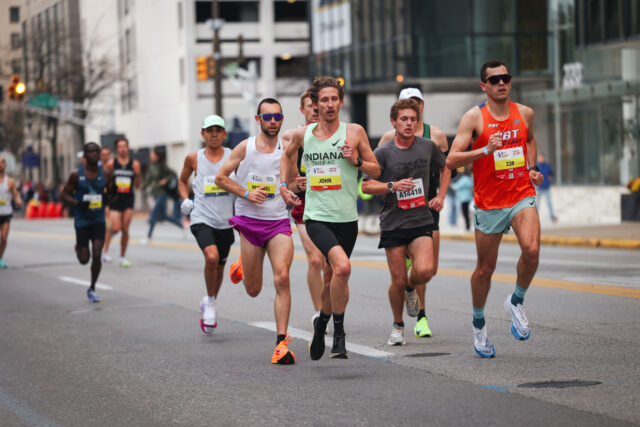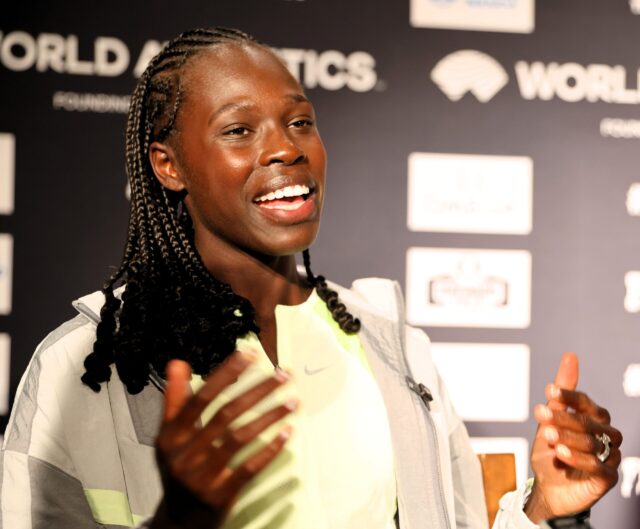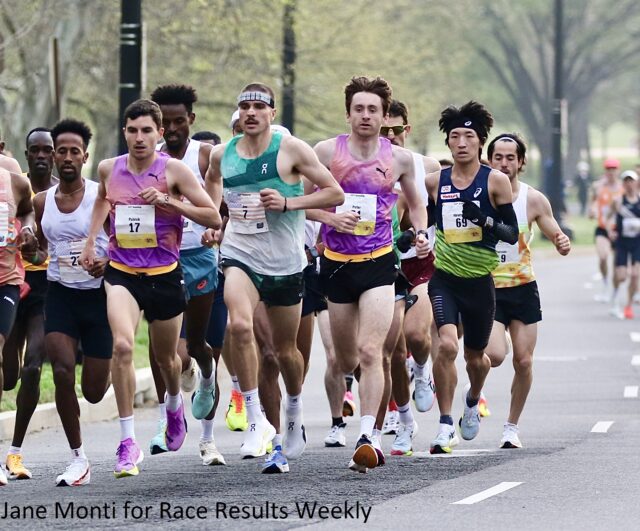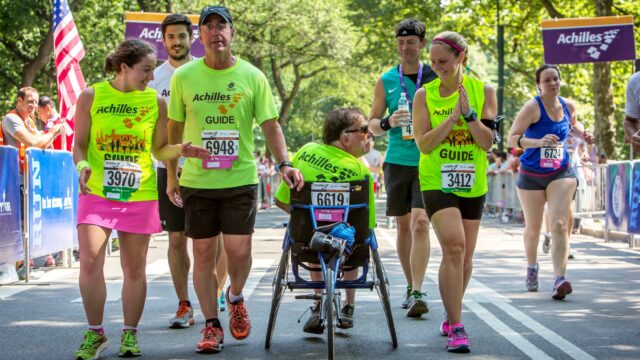Small Business

How to Attract Elite Athletes to Your Event
Something that makes running unique from nearly any other sport is that your neighborhood weekend warrior can — and often does — compete in the same races as world-class athletes. Spend a few hours at the finish line of any major marathon, and you’ll likely see Olympians, former college athletes, and beginner runners alike.
Having high-performing athletes at your event can help raise its prestige and grow its popularity. Often, catering to elite, sub-elite, and locally competitive runners is mutually beneficial for these athletes and the reputation of your event.
Here are some things you should consider when planning to host elite athletes and tips for attracting them to your race.
Consider your budget and race size
Not every race is equipped to host the reigning Olympic or World champions, and that’s okay. For the best-of-the-best runners, running is typically their full-time career. These professional athletes, in part, rely on prize money earned from racing to pay their bills and support their families. That’s one reason why you most often see pro runners participating in major races like the Chicago, New York City and Boston Marathons, which offer six- and five-digit prize purses along with hefty appearance fees and highly competitive fields.
Still, this doesn’t mean you can’t attract plenty of talented runners to your event. Most up-and-coming elites, sub-elites, and competitive amateurs have day jobs and don’t expect to earn a substantial check from racing. Instead, they value other perks like discounted race fees, exclusive and convenient accommodations, travel and lodging allowances, and the proper competition and conditions to run a personal best.
Determine your elite time qualification standards
Before considering how you’ll attract elite athletes, you need to determine who qualifies as “elite” at your race. There is no universal time standard for an elite race field; instead your event organizers get to determine it. Additionally, some race organizers update their standards annually — or even throughout the year as race day gets closer and the elite field begins filling up.
Most often, time standards are based on the size, historical competitiveness, and prestige of your race. For example, a recent performance of 3:00:00 for a woman and 2:40:00 for a man may qualify for an “elite” entry at a relatively small, local or regional marathon. Meanwhile, many of the nation’s largest marathons require a time of at least 2:45:00 for women and 2:25:00 for men.
If you’re unsure where to set your time standard, review the websites of a few similarly sized races, or talk with fellow race directors through Running USA. It could be smart to set a similar standard to races comparable to yours. Additionally, keep in mind that a runner’s qualifying time should reflect their current abilities. It is common to require athletes to have run your event’s time standard within two years of your event in order to be considered for the elite field.
Some races offer a two- or three-tiered system, with each tier having stricter time standards and more perks as you move up. For example, the 2025 Indianapolis Monumental Marathon offers elite, seeded elite, and sub-seeded elite categories:
Indianapolis Monumental Marathon elite athlete and pace team coordinator Matt Ebersole said having three athlete tiers enhances the race’s depth and energy. Plus, it empowers young and developing athletes. He said he doesn’t want the elite race to be so much faster than the general one that they “essentially become two separate races.”
“I love standing at the finish line, and, after the first runner comes by, they just keep coming,” Ebersole said. When it comes to developmental athletes, including those hoping to qualify for the Olympic Trials, he said, “We can give them a taste of that elite treatment. It’s great for up-and-coming runners to come into an elite area and see people they know or maybe follow on social media. After the race, that inspires them to train harder and do what they need to do to get to that level.”
As you can see in the Indy example, while the time standard is often based on the same race distance as your event, it doesn’t have to be. If you plan to offer equivalent time standards (such as permitting a half marathon or 10K time to qualify an athlete for an elite marathon field), it could be helpful to use free online tools like the McMillan Running Calculator to determine equivalent performances.
Here’s how Indy’s elite “perks” increase with each tier:
Having different levels of perks allows Indy to provide more runners with the elite treatment while being cognizant of physical space and financial resources. “We want to make sure (the elites) are having a great experience while not taking away from the experience of anyone else,” Ebersole said.
Should you ever make exceptions to your time standard?
Ebersole shared that while he doesn't make many exceptions to Indy’s posted time standard, he thoroughly looks at every application to see where and when each athlete ran their qualifying time.
“If someone’s close and they ran it on a downhill course, then it’s a no,” he said. “If they ran close on a hot day at the Boston Marathon, then yes … or if someone was pregnant last year and doesn't have a recent performance but they have a strong history of racing well over the last several years. So, it depends on the situation.”
Encouraging elites to register for your event
Word spreads quickly in the running community. Elite participants will likely tell their friends, training partners, and teammates if your race was well organized, competitive, and fun.
But, if your race is new or returning after a long hiatus, it’s crucial to promote it and connect with athletes online and in-person if you want competitive runners at your start line.
Here are some helpful tips:
● Have a designated elite athlete coordinator on your team who can advise the team on decisions regarding the elite field, answer questions from elite athletes and their coaches, and go through applications for the elite field.
● Connect with high school varsity, collegiate, sub-elite, and elite teams in your city, state, or region. Offer discounted or free entries to anyone on the team interested in signing up for your event. With high school and college teams, be aware that athletes may be unable to participate in your event during their fall and spring competition seasons.
● Contact your local running clubs and running specialty stores. See if they can help connect you with nearby runners who meet your time standards or can suggest athletes for you to contact.
● Don’t be afraid to reach out if you know of an elite athlete of any level who has a personal, geographic, or other connection to your event (perhaps your race benefits a cause they’re passionate about). Some runners, including top performers, may surprise you with their willingness to participate. Even if a runner can’t compete in your event, they may be interested in making an expo or finish-line appearance.
● With the athletes’ permission, feature elite participants on social media ahead of your event. Ask the athletes to share on video or in writing what inspired them to sign up for your event, how they are preparing, and what they hope to achieve. Share these posts on your event’s social media accounts and encourage featured athletes to repost them. If a runner’s training partners, teammates, and competitors see that they’re excited about your event, they’re more likely to check it out themselves and possibly register. As mentioned, high-level runners are attracted to opportunities to push themselves in a competitive field. If an elite runner knows that many athletes of their caliber have enthusiastically signed up for a race, they won’t want to miss out!
A note on agents: When working with the highest level of elite runners (think Olympic and/or professional), you’ll likely communicate with the athlete’s agent rather than the runner themselves. Top athletes pay their agents to negotiate entry into races, including appearance fees. Agents also assist with travel and lodging arrangements.
What perks are elite runners looking for?
Below are some common perks that are attractive to (and sometimes expected by) elite runners. If you plan to offer any of these at your race, be sure to publicize them on your event website and social media so athletes are aware prior to registration.
1. Free or discounted race entries: Many races offer free or discounted registration fees to athletes who meet certain time standards. Sometimes, this is the same standard required for entry into the elite field. Other times, an even faster qualifying time is required for a free entry while “slower” elites receive a discount. Like time standards, you can implement multiple discount tiers.
2. Lodging and travel stipends: Some races, especially larger ones, offer travel stipends and/or lodging for elite athletes. This is less common at smaller races. Again, you should consider the size and budget of your event. See the travel and lodging perks offered at the 2025 Grandma’s Marathon:
3. Elite bottle stations: Any good race will have water, electrolytes, and possibly other aid stations along the route. However, many high-level athletes prefer a special hydration or nutrition blend unique to their needs, especially in longer-distance races like a marathon. If you’re hosting elite marathoners, highly consider providing elite bottle stations — exclusive tables throughout the race where elites can easily grab their special, in-race nutrition. Be sure to arrange a way for athletes to provide your staff/volunteers with their bottles ahead of time.
4. Special pre-race waiting area: Help ease race morning stress by offering an elites-only, pre-race waiting area near the start line of your event. Athletes will probably be most grateful to have elites-only bathrooms and skip the porta-potty line! Also consider providing water and space for runners to stretch and warm-up before the race.
5. Prize money and record bonuses: Even if you can’t offer thousands of dollars to the athletes who make your event’s podium, consider awarding small prizes to the top three or five finishers in the elite field. Many races also offer additional monetary bonuses for breaking the event’s course record. Make sure to publish the current record and bonus prize amount ahead of time to encourage athletes to go for it!

Mu-Nikolayev To Run Her First 800m In Nearly A Year At Prefontaine Classic
(c) 2025 Race Results Weekly, all rights reserved. Published with permission.
EUGENE (04-Jul) -- When she takes to the track to run the Mutola 800m at the 50th Prefontaine Classic at Hayward Field here on Saturday, it will have been 351 days since Athing Mu-Nikolayev will have competed at the distance where she won the Olympic gold medal in Tokyo in 2021 and set the American record of 1:54.97 in 2023. Under coach Bobby Kersee the 23 year-old athlete has been returning to competition slowly, focusing on over-distance races including a 5000m (where she dropped out as planned at 3000m), and two 1500's where she ran modest times of 4:21.18 and 4:10.70, respectively. It's all part of Coach Kersee's plan to have the former high school star from Trenton, N.J., healthy and in peak shape for the World Athletics Championships in Tokyo in September.
"On the track side of things I think people have learned to understand that he knows what he's doing," Mu-Nikolayev said of Kersee at a press conference here yesterday. "And though he may take different approaches that other coaches may not take, whether it's more risky and not of the norm, in the end his plan works out the best for his athletes, and he does not steer us the wrong way. Just growing in trust together has been a big thing over the past couple of years."
Mu-Nikolayev, who trains with four-time Olympic gold medalist Sydney McLaughlin-Levrone, is trying to bounce back from a disappointing year. At last summer's USA Olympic Team Trials, also held here in Eugene, Mu-Nikolayev tripped and fell in the 800m final just 200 meters into the race. She regained her feet, finished in last place, and did not qualify for the Paris Olympics. She ran only one other race before shutting down her season, and she did not return to competition until April 18, 2025, where she ran the first 3000 meters of the 5000m at the Mt. SAC Relays in Walnut, California.
"It's more fun to do it out here than in practice, just in terms of getting some longer runs in," Mu-Nikolayev said in her post-race interview when asked why she had competed at Mt. SAC. "It was definitely long, longer than 800m, longer than 1500m."
While the two 1500's reacquainted her with faster running, those races were nothing like what she will face on Saturday when she will square-off against 2023 world champion Mary Moraa of Kenya, 2024 world indoor champion Tsige Duguma of Ethiopia, 2021 Olympic bronze medalist Raevyn Rogers of the United States, and 2025 world indoor champion Prudence Sekgodiso of South Africa, among others. The world-leading time of 1:56.64, set by Duguma in China in May, is likely to come under threat.
"I think this is falling at the perfect time for preparation for the USA's and, obviously, world championships in September," Mu-Nikolayev said of Saturday's race. She continued: "It's really great to be able to run a fast, competitive 800 around this time of the year."
All of Mu-Nikolayev's competitors have already been racing hard this season, which would seem to leave her at a disadvantage. That's not how Mu-Nikolayev sees it.
"You have to trust your coach if you want to improve and get better with them," Mu-Nikolayev explained. "So, that's just a super-important thing that I hold with Bobby and Bobby holds with me. So, I trust that year to year, if we have to adjust things, do things different, that in the end he'll have me ready for what's most important, championships, whether the Olympics or worlds."
Saturday's race is named after Maria Mutola, the legendary runner from Mozambique who won the Olympic 800m title in 2000 and was the world 800m champion in 1993, 2001 and 2003. Mutola, now 52, won the 800m at the Prefontaine Classic a dozen times from 1992 to 2008. Mu-Nikolayev has won it twice, in 2021 and 2023, setting meet records both times. She definitely enjoys running at Hayward Field, although she appeared to be slightly nervous about doing a "rust-buster" in such hyper-competitive circumstances.
"I'm super-excited, actually, to be back here at the Pre Classic," Mu-Nicolayev told reporters. She continued: "I'm just excited to go out and just see where my body is at this point of the year in the 800. I'm excited to run fast; I know it's not going to be a slow race."
When asked whether she had a time goal, Mu-Nicolayev said she wanted to break two minutes. She added: "I think just going out there and feeling good, both mentally and physically, is the most important thing for me. And seeing the results, obviously, no matter what the time may be, is always a plus. But, I think just completing that race, doing two full laps, would be a really great thing."
PHOTO: Athing Mu-Nikolayev speaking with reporters at the 50th Prefontaine Classic press conference in Eugene, Oregon (By Jane Monti for Race Results Weekly)

5 Questions with Lena Andersson, Founder and CEO of Go! Running Tours
Running USA's Leah Etling sat down with Lena Andersson, the visionary behind Go! Running Tours — a global network that combines sightseeing with sweat, offering guided running experiences in cities around the world. From the company's beginnings to leading a worldwide movement of running tourism, Lena shares her journey, insights on entrepreneurship, and the power of exploring cities one stride at a time.

Now Focused On The Roads, Klecker To Run Boston 10K On Sunday
(c) 2025 Race Results Weekly, all rights reserved. Published with permission.
(18-Jun) - After a difficult year where an adductor injury forced him to be sidelined and miss the USA Olympic Team Trials and, by extension, the Paris Olympics, Joe Klecker has begun a new phase of his career where he is focused on road racing. The 28-year-old, who trains with the On Athletics Club in Boulder, Colo., had never run a road race longer than a mile until this January. But since the beginning of this year he has run five, highly-competitive road races and will do a sixth, the Boston 10K, on Sunday. It's a transition that he and coach Dathan Ritzenhein had planned for a while, even if the timing had changed.
"The big picture was always in the off-year after Tokyo (2025 World Championships), make that transition," Klecker explained to Race Results Weekly in a telephone interview on Tuesday. "Then I got injured, pretty significantly, and we kind of thought that this might be the right time to push it up a year."
Klecker had a complicated injury involving the intersection of his left adductor, a muscle on the inside of the thigh, and his abdominal muscles. He announced in May, 2024, that he could not make it to the starting line for the Trials where he had hoped to make his second Olympic team in the 10,000m. What he didn't know at the time was that the injury would take the better part of a year to heal, and still lingered into January, 2025, when he made his half-marathon debut at the Aramco Half-Marathon in Houston.
"It was an interesting injury," said the always-thoughtful Klecker. "I would say it lingered until about December, or January, around the time of Houston. I would say I was 90% healed, but it was the type of thing that after a hard effort, you'd still have some awareness of the injury. But, for the last three months, since February or March, it's been completely gone."
The Houston event was a road racing baptism by fire. It's America's fastest half-marathon, and on a cold morning the pack went out at 14:02 for the first 5K and 28:01 for 10K. That was too hot for Klecker whose splits were a more reasonable 14:13 and 28:38. He ran a very solid 1:01:06, but finished 18th, nearly two minutes behind the winner. It was at that moment that he realized that there was going to be a bigger learning curve than he thought to master the roads.
"The original plan was just to do Houston and then go into a track season," Klecker said. "But once I did Houston I just kind of saw the level that the roads were at. I was like, wow, this is going to be a bigger transition than I thought." He added: "Those guys were ripping."
Ritzenhein was on the same page.
"That injury he had in spring of '24 was tough to miss out on his second Olympic team," Ritzenhein told Race Results Weekly in a text message. "But I'm amazed how dedicated he was to the transition to the roads after that. It's been a longer process than we thought."
Klecker decided to do another half-marathon in early March, the USATF Half-Marathon Championships in Atlanta. That was a completely different kind of race, held on a hilly course with a lot of turns and with no pacemakers. He ran a similar time, 1:01:34, but had a better competitive experience.
"That one I was ready for the punches, early," said Klecker, who finished eighth in an all-American field. "That one, Hillary Bor really fartleked that race. We took it out in about a 4:20 mile, and we were running very fast for the first, eight to ten miles of that course. We were just ripping." He continued: "I was very proud of a lot of stuff in that race. It was very close to being a great day. It was just around ten miles that I lost the pack."
But Klecker was getting more comfortable racing in 40mm stack-height road shoes and managing the varied terrain and surges of road racing. When he went into the Credit Union Cherry Blossom 10-Miler in Washington, D.C., on April 6 (another USATF Championships), he was ready for the hard, early miles. He was with the leaders at 5K in a very fast 13:58, and just a few seconds back at 10K in 28:12, effectively setting a new road PB for that distance.
But the course has several sharp turns, including a 180-degree turnaround after the 10K mark. Klecker fell back on those turns forcing him to surge in order to catch up, using valuable energy. He finished ninth in 46:08. More lessons were learned.
"I learned a lot from that one," Klecker said. "I knew it was going to be fast and I wanted to kind of sit in the pack, but... there are a lot of turns. If you sit in the back of the pack, a pack of like ten people, can really string out around these turns. And then you really have to work hard to bring it back together. With how fast the pace was I was really putting in a lot of energy every turn."
With plenty of miles in his legs and all of the learning from the first three races, Klecker put together his best road race at the USATF 25-K Championships in Grand Rapids, Mich., on May 10. He not only wanted to win that race, but also wanted to use the race as a marathon simulation because, in practical terms, 25 kilometers is the longest an athlete can race in the United States without doing the full marathon distance.
Competing against Casey Clinger and Hillary Bor, the trio split the half-marathon in 1:01:14, essentially the time he ran in Houston back in January, but now he had another four kilometers to run.
"I was leading for probably 14 miles," Klecker recounted. "I didn't have so much of a plan, but during the race I know Hillary would probably want to throw in some surges. To kind of play the mental game, whenever he tried to throw in a surge I would counter with my own surge. I could sense him getting a little bit frustrated during that race, which is some of the fun aspect of the battle that we had."
Clinger set a national record of 1:12:17 to get the win, and Klecker finished second in 1:12:32, also well under the previous national record. Things were starting to click for Klecker.
"I was actually able to feel like I was racing, versus trying just to hang on to a pack, which is how it felt in Atlanta and at Cherry Blossom," Klecker said. "I was really just reacting and trying to hang on, versus really feeling like I'm breaking my competitors, or trying to break them with moves and surges. It's really empowering."
As a former University of Colorado Buffalo, Klecker thought it was important to run the high-altitude BOLDERBoulder 10K on Memorial Day, even though it was only 16 days after the Grand Rapids race. His legs were not fully recovered, but it was thrilling to enter a packed football stadium where the race finishes. He placed a solid sixth in 29:13.
"After Grand Rapids Dathan came up to me and said, look, this is going to take a lot out of you," Klecker recounted. "We really need to think if we're going to do Bolder Boulder still. It's so hard to pass up a race of that caliber which is literally a ten minute drive from my house."
Klecker passed up the USATF 4-Mile Championships last Saturday in Peoria, Ill., so he could be fully rested and prepared for Sunday's 10K in Boston. He's looking forward to a high level of competition, but also a mostly-flat, sea level course.
"Dathan always says that the number of miles the race is, that's how many days it takes until you start feeling good again," Klecker said. He continued: "We took the 4-mile championship off the calendar so that we made sure we got in three weeks of good training. Last week we started resting-up, then this week more rest. I told Dathan going into this one I want to make sure I'm on fresh legs."
From Boston, Klecker may be headed back to the track. Or not. He's eyeing the 10,000m which will be held at the Prefontaine Classic on July 5th as a possible return to the track (the race will be the Kenyan Trials for the World Championships). If he runs there and has a great day, he might do the USATF Track and Field Championships at the end of July and try for a team spot for Tokyo.
Maybe.
"I'm not holding too firm to any plans because my most important race is always my next race," Klecker said. "Tentatively, I want to run the 10K at Pre and see how that goes, then maybe put a 5K on the calendar." He continued: "Depending on what I run at Pre, if I run 27:10, no. If I run 27-flat, maybe. But I think the faster I run at Pre that would set the gauge for do I want to run at the Trials and try to make Tokyo. It's not the focus that it was in years past."
For the fall, Klecker is keeping his options open. He might make a marathon debut, or do a slate of shorter road races. Moving up to the marathon is the main goal, but he and Coach Ritzenhein are flexible on the timing, and on the specific race.
"Since Grand Rapids went really well, we'll consider one this fall," said Klecker. "We haven't committed to anything yet, but it's definitely on the table to do a debut this fall." He continued: "I think getting the experience earlier is very valuable. That's kind of what Grand Rapids showed me, that everything with the training is trending in that direction."
PHOTO: Joe Klecker competing at the 2025 Credit Union Cherry Blossom 10 Mile in Washington, D.C. (photo by Jane Monti for Race Results Weekly)

Running USA and Achilles International Webinar: Best Practices for Making Your Race More Accessible
Organizing a race is more than just planning a fast, fun course—it’s about building an event that embraces all athletes, including those with disabilities. On June 10, 2025, Achilles International teamed up with Running USA to host a webinar titled “Best Practices for Making Your Race More Accessible.” Find key takeaways on the Achilles International website here
Panelists Francesco Magisano, Director, NYC Metro, at Achilles International, and Janet Patton, Vice President of Strategic Partnerships, Achilles International, offered a wealth of actionable insights across every stage of race planning—from registration to post-finish celebrations.
1. Registration
Simplify sign-up: Ensure your online process and race forms are compatible with assistive technologies and include accommodations for guide runners.
Gather participant info: Provide options to disclose wheelchair use, handcycles, guides, etc., to tailor support.
Show representation: Use inclusive images and proper alt text to reflect diverse participants.
Facilitate communication: Allow participants to request a guide runner directly and consider offering guides free of charge.
Centralize resources: Create a dedicated web page outlining athlete resources and maintain open email contact for accommodation questions.
2. Pre-Race Planning
Thoughtful logistics: Include accessibility in corrals, announcements, start times, and volunteer/staff training.
Educate volunteers: Teach the difference between racing wheelchairs, handcycles, etc., so support teams and spectators understand and celebrate appropriately.
Clear communication: Warn participants and staff about arrival times for wheeled athletes and potential safety issues.
Facility readiness: Ensure accessible restrooms and bag drop areas; consider ASL interpreters and sensory calm-down zones.
Course insight: Alert athletes and guides beforehand about terrain challenges or layout changes.
3. On-Course Considerations
Barrier-free route: Limit curbs, stairs, narrow paths, cobblestones, and sharp turns—adapt or detour where needed.
Safety protocols: Enforce speed rules, use warning flags or signage, and assign bike escorts when appropriate.
Mechanical aid: Station quick-repair crews for wheelchairs/handcycles; flag low-profile handcycles for better visibility.
4. Post-Race & Celebration
Accessible finish area: Design flow patterns that accommodate adaptive equipment and personal assistants.
Equitable ceremonies: Structure award ceremonies and recovery zones with wheelchair users in mind.
Visible signage: Ensure directional and informational signs serve all athletes.
Acknowledgment: Recognize athletes with disabilities in speeches and awards to elevate inclusion.
Key takeaways: You don’t have to implement everything at once. Even one simple tweak—like adding an accommodation email or guide request field—can make a meaningful difference. These incremental steps pave the way for a more inclusive race experience.
When in doubt, treat athletes with disabilities with the same patience, respect, and care you’d want. At the heart of inclusivity lies empathy—and every thoughtful adjustment enriches the event for all participants.